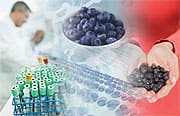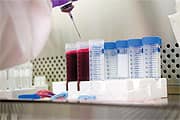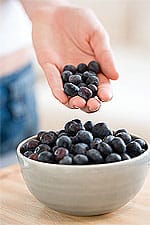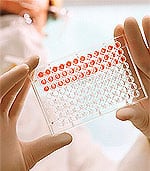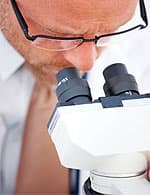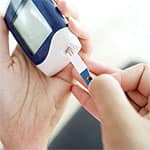Life Extension Magazine®
The ability of blueberry polyphenols to combat diabetes first gained scientific validation over 80 years ago. This groundbreaking data appeared in mainstream medicine’s revered bastion of knowledge—the Journal of the American Medical Association (JAMA). This landmark JAMA report published in 1927 revealed the ability of a specific blueberry extract to slash blood sugar levels.1 The totality of the evidence was so compelling, the author called it the one compound to date that came closest to curing diabetes. Of course, the conventional physicians on JAMA’s editorial board saw fit to refute these findings. They argued that such extracts could not be standardized, dismissing the blueberry compounds under study as a “new and non-official remedy.” Mainstream doctors today persist in making similar pronouncements about natural interventions. Life Extension® members know better. In this article, you will discover up-to-date data vindicating blueberry polyphenols’ promise in combating the factors that result in deadly metabolic syndrome—the co-occurrence of insulin resistance, hypertension, abdominal obesity, and abnormal blood lipid profiles that increases the risk of heart disease and diabetes. You will learn how blueberries may boost insulin sensitivity, lower LDL cholesterol and triglycerides, and improve leptin sensitivity, which has been associated with reduced appetite and lower body weight. You’ll also discover the potential of blueberry polyphenols to halt the progress of the disease in humans who are already diabetic. Finally, detailed evidence is presented of the potential ability of blueberry extract to combat multiple forms of cancer—for which metabolic syndrome sufferers are at greater risk than the general population.2 Defusing Diabetic Risk FactorsResearchers around the world have been steadily amassing evidence of blueberry polyphenols’ anti-diabetic action on carbohydrate metabolism—the core physiological function that becomes pathologic in diabetics.
Some of the most recent published studies3-6 highlight the capacity of blueberry extract to protect against elevated glucose and hyperglycemic toxicity,7,8 facilitate absorption of glucose into muscle tissue,9 and to thwart adipogenesis,10 the formation of new body fat stores. Biochemical assays have also shown that blueberry extracts are potent inhibitors of the alpha-glucosidase and alpha-amylase enzymes, which break down dietary starch into glucose for absorption into the blood.11,12 Recent pre-clinical models have confirmed their anti-obesity and anti-diabetic effects. In a 2010 study,13 control groups of mice were fed either a low- or high-fat diet, while experimental groups also received blueberry juice or extracts in their drinking water. After 72 days, the high-fat diet control group showed increased body weight and higher body fat percentage compared to the low-fat group. However, when the high-fat groups that also received blueberry juice or extract were examined, they exhibited no difference in body fat compared to the low-fat group. In other words, the simple addition of concentrated blueberry polyphenols into the high-fat diet group blocked body fat accumulation. The same held true for fasting glucose levels. The high-fat diet control group exhibited very high fasting glucose, whereas the high-fat group given blueberry extracts was found to have fasting glucose levels identical to the low-fat group. Blood levels of the hormone leptin, secreted by fat cells and sometimes called “the hunger hormone,” rose significantly in the high-fat diet group, while the blueberry-supplemented high-fat group showed lowered leptin levels. (Reduced blood leptin has been associated with reduced appetite and lower body weight.) The authors added that blueberry juice did not prove as effective as blueberry extract in attaining these results. A similar experimental model revealed normalization of elevated blood lipids—cholesterol and triglycerides in particular—in mice given a high-fat diet that were also fed blueberry extracts or whole blueberries.14 The experimental group fed blueberry extracts gained less weight and had lower body fat than animals fed the high-fat diet alone. Researchers also noted in this study that they did not observe the same lipid-lowering effect in the group fed whole berries as opposed to purified berry extract. Other scientists have corroborated these findings using an enriched blueberry juice with high antioxidant and polyphenol content.9 The experimental group whose drinking water contained this fortified blueberry juice ate less, weighed less, and had lower blood sugar levels than controls. A Potent Intervention in Pre-Diabetic HumansThese remarkable results have prompted researchers to examine blueberry’s impact on blood lipid profiles, insulin sensitivity, and cardiovascular health in aging humans at risk for diabetes—or already diabetic. Some have identified a role for blueberry extracts in halting the progression to full-blown diabetes in at-risk or pre-diabetic individuals. In a recent double-blind, placebo-controlled study, 32 obese, insulin-resistant (pre-diabetic) adult men and women drank smoothies made with freeze-dried blueberry powder for six weeks. A placebo control group consumed smoothies without blueberry extracts.5 Participants were carefully screened and counseled by dieticians both before and during the study to avoid eating other anthocyanin-rich foods or beverages. In another measure of the study’s rigor, participants were also instructed about ways to decrease caloric intake to compensate for the caloric energy load of their twice-daily smoothies. Further, blood samples were obtained following a fasting period with a clamp technique considered state-of-the-art for precise determination of insulin sensitivity. Besides measurements of body composition, weight, and adiposity, blood was also drawn for a host of inflammatory markers. With no changes in body weight or composition compared to controls, the blueberry group showed a statistically significant and much greater improvement in insulin sensitivity (22.2% plus or minus 5.8%) versus the placebo arm (4.9% plus or minus 4.5%). Another study15 examined 48 individuals afflicted with metabolic syndrome, the constellation of pathologies that includes high blood pressure, central obesity (around the abdomen), elevated blood glucose, insulin resistance, and unfavorable lipid profiles (high LDL cholesterol and triglycerides and low HDL cholesterol). In this randomized, controlled trial, participants consumed a freeze-dried blueberry drink or an equal amount of fluids. After eight weeks, the blueberry group experienced greater decreases in systolic and diastolic blood pressure readings, compared with the control group. The test group also exhibited lower levels of oxidized LDL and other inflammatory markers associated with the metabolic syndrome.
Blueberry Extract’s Anti-Cancer PowerAs detailed in the November 2010 issue of Life Extension Magazine®, diabetics are predisposed to a horrifically wide array of cancers, including those of the breast, liver, colon, pancreas, endometrium (uterine lining), kidney, and possibly other tissues.16-18 Just as the anti-diabetic drug metformin has proven a potent anti-cancer agent, blueberry extracts are emerging as powerful chemopreventive interventions as well. In vitro studies have revealed a host of anti-cancer properties shared by blueberry anthocyanins and other flavonoids found in brightly colored fruits and vegetables.19 Their biochemical structure enables them to powerfully neutralize reactive oxygen species (ROS). By inflicting damage to cell structure and DNA, ROS can induce the development of cancer in healthy cells. Using many different types of cancer cell lines in the laboratory, scientists have demonstrated anthocyanins’ capacity to neutralize harmful ROS.
Researchers have discovered that blueberry anthocyanins combat cancer development in three distinct ways:
Pre-clinical studies have confirmed these effects. Using experimental models of cancer, blueberry polyphenols display the ability to slow or inhibit tumor growth altogether. These include blocking esophageal cancer in rats using a mixed berry preparation,20 colon cancer inhibition in rats with pterostilbene, a constituent of blueberries,21 and protection from skin cancer–causing UVB ultraviolet radiation and DNA damage in mice skin.22 In one animal experiment with direct relevance to human tumor biology, researchers devised a model to investigate a possible nutritional approach to a common type of tumor seen in infants known as endothelial cell neoplasms. A control group of mice was given injections of a cell line known to cause hemangioendothelioma, a type of skin tumor, and was fed orally with a standard liquid. Test mice injected with the same tumor-causing cell line also received a liquid feeding that contained a standardized blueberry extract.23
After the test period, the investigators found dose-dependent smaller tumor size and enhanced survival in the blueberry extract–treated group compared to controls. That is, animals that received higher doses of blueberry extract had a greater reduction in tumor size than those that received lower doses. Molecular and biochemical assays showed less oxidative stress in extract-treated animals. They also observed greater antioxidant activity, inhibition of tumor-signaling pathways, and diminished proliferation of the type of blood vessel cells that lead to uncontrolled tumor growth.23 Other studies have shown that blueberries and other anthocyanins have the ability to block the runaway growth of tumor cells in tissue culture. In particular, they induce apoptosis or programmed cell death. These studies show promise regarding blueberries’ ability to combat tumor growth in animal models of esophageal, colon, lung, and skin cancer.19,24 Chemoprevention in HumansGiven these promising findings, a multinational group of European researchers led by Marta Rossi of the Mario Negri Pharmacologic Research Institute in Milan, Italy, recently reported on polyphenols and other compounds found in blueberries and other fruits in relation to tumor risk.25 Using a similar study design, these researchers have compared relative risk for colorectal26 cancers in large patient groups with and without tumor growth in retrospective case-control studies. Rossi and colleagues used a detailed food-frequency questionnaire with US Department of Agriculture (USDA) nutrient and food-composition databases to extrapolate average intake of polyphenols, such as those found in blueberries and other fruits. After comparing the dietary data of patient groups with tissue-confirmed tumors to matched controls admitted to the same hospitals for acute but non-cancerous conditions, Rossi and colleagues estimated an odds ratio for cancer risk as a function of polyphenol intake. Using this method, the researchers concluded that the polyphenols found in blueberries and other fruits may exert a protective effect against these cancers.25,26 In laboratory and animal studies, blueberry extract has proven effective in fighting triple-negative human breast cancer cell lines, which are among the most aggressive forms of breast cancer. In the laboratory, blueberry extracts decreased cell signaling pathways involved in the spread of cancer. In an animal model of human breast cancer, blueberry extracts decreased tumor weight and proliferation, while increasing cancer cell death.27 The anti-cancer benefits of blueberries may arise from their potent antioxidant activity. When scientists assayed 25 fruits commonly consumed in the United States, they found that blueberries and other berries, along with pomegranates, demonstrated the highest cellular antioxidant activity. They proposed that increasing consumption of fruits such as blueberries may thus decrease oxidative stress, reducing the risk of cancer.28 Berry polyphenols have also demonstrated the ability to protect genomic DNA integrity, thereby preventing mutations that can lead to cancer. In addition to fighting oxygen free radicals, berry extracts demonstrate anti-angiogenic effects and inhibit the expression of nuclear factor-kappaB (NF-kB), a factor that turns on genes involved in inflammation and cancer.29
SummaryThe power of blueberry polyphenols to combat diabetes first gained scientific validation in this country over 80 years ago in the Journal of the American Medical Association. Its author argued they were the closest thing to a “cure” for diabetes known to modern science at the time. Yet mainstream medicine has ignored this natural intervention. Recent research indicates a significant role for blueberry polyphenols in favorably altering the factors that contribute to metabolic syndrome: high blood sugar, abdominal obesity, adverse lipid profiles, insulin resistance, and high blood pressure. Given that metabolic syndrome sufferers are also predisposed to a broad range of cancers, it is both significant and encouraging that blueberry polyphenols have emerged recently as potentially powerful anti-cancer agents. If you have any questions on the scientific content of this article, please call a Life Extension® Wellness Specialist at 1-866-864-3027.
Editor's NoteScience continues to evolve, and new research is published daily. As such, we have a more recent article on this topic: Blueberries Reduce Heart Disease Risk Factors |
||||||||||||||
| References | ||||||||||||||
| 1. Allen FM. Blueberry leaf extract: physiologic and clinical properties in relation to carbohydrate metabolism. JAMA. 1927 Nov 5;89(19):1577-81. 2. Cowey S, Hardy RW. The metabolic syndrome: a high-risk state for cancer? Am J Pathol. 2006 Nov;169(5):1505-22 3. Hanhineva K, Torronen R, Bondia-Pons I, et al. Impact of dietary polyphenols on carbohydrate metabolism. Int J Mol Sci. 2010 Mar 31;11(4):1365-402. 4. Jayaprakasam B, Vareed SK, Olson LK, Nair MG. Insulin secretion by bioactive anthocyanins and anthocyanidins present in fruits. J Agric Food Chem. 2005 Jan;53(1):28-31. 5. Stull AJ, Cash KC, Johnson WD, Champagne CM, Cefalu WT. Bioactives in blueberries improve insulin sensitivity in obese, insulin-resistant men and women. J Nutr. 2010 Oct;140(10):1764-8. 6. Abidov M, Ramazanov A, Jimenez Del Rio M, Chkhikvishvili I. Effect of Blueberin on fasting glucose, C-reactive protein and plasma aminotransferases, in female volunteers with diabetes type 2: double-blind,placebo controlled clinical study. Georgian Med News. 2006 Dec;(141):66-72. 7. Nemes-Nagy E, Szocs-Molnar T, Dunca I, et al. Effect of a dietary supplement containing blueberry and sea buckthorn concentrate on antioxidant capacity in type 1 diabetic children. Acta Physiol Hung. 2008 Dec;95(4):383-93. 8. Martineau LC, Couture A, Spoor D, et al. Anti-diabetic properties of the Canadian lowbush blueberry Vaccinium angustifolium Ait. Phytomedicine. 2006 Nov;13(9-10):612-23. 9. Vuong T, Martineau LC, Ramassamy C, Matar C, Haddad PS. Fermented Canadian lowbush blueberry juice stimulates glucose uptake and AMP-activated protein kinase in insulin-sensitive cultured muscle cells and adipocytes. Can J Physiol Pharmacol. 2007 Sep;85(9):956-65. 10. McDougall GJ, Shpiro F, Dobson P, Smith P, Blake A, Stewart D. Different polyphenolic components of soft fruits inhibit alpha-amylase and alpha-glucosidase. J Agric Food Chem. 2005 Apr 6;53(7):2760-6. 11. Vuong T, Benhaddou-Andaloussi A, Brault A, et al. Antiobesity and antidiabetic effects of biotransformed blueberry juice in KKA(y) mice. Int J Obes (Lond). 2009 Oct;33(10):1166-73. 12. Melzig MF, Funke I. Inhibitors of alpha-amylase from plants--a possibility to treat diabetes mellitus type II by phytotherapy? Wien Med Wochenschr. 2007;157(13-14):320-4. 13. Prior RL et al. Purified blueberry anthocyanins and blueberry juice alter development of obesity in mice fed an obesogenic high-fat diet. J Agric Food Chem. 2010 Apr 14;58(7):3970-6. 14. Prior RL et al. Purified berry anthocyanins but not whole berries normalize lipid parameters in mice fed an obesogenic high fat diet. Mol Nutr Food Res. 2009 Nov;53(11):1406-18. 15. Basu A, Du M, Leyva MJ, et al. Blueberries decrease cardiovascular risk factors in obese men and women with metabolic syndrome. J Nutr. 2010 Sept;140(9):1582-7. 16. Czyzyk A, Szczepanik Z. Diabetes mellitus and cancer. Eur J Intern Med. 2000 Oct;11(5):245-52. 17. Vigneri P, Frasca F, Sciacca L, Pandini G, Vigneri R. Diabetes and cancer. Endocr Relat Cancer. 2009 Dec;16(4):1103-23. 18. Martin-Castillo B, Vazquez-Martin A, Oliveras-Ferraros C, Menendez JA. Metformin and cancer: Doses, mechanisms and the dandelion and hormetic phenomena. Cell Cycle. 2010 Mar 21;9(6). 19. Wang LS, Stoner GD. Anthocyanins and their role in cancer prevention. Cancer Lett. 2008 Oct 8;269(2):281-90. 20. Stoner GD, Wang LS, Chen T. Chemoprevention of esophageal squamous cell carcinoma. Toxicol Appl Pharmacol. 2007 Nov 1;224(3):337-49. 21. Paul S, DeCastro AJ, Lee HJ, et al. Dietary intake of pterostilbene, a constituent of blueberries, inhibits the beta-catenin/p65 downstream signaling pathway and colon carcinogenesis in rats. Carcinogenesis. 2010 Jul;31(7):1272-8. 22. Afaq F, Syed DN, Malik A, et al. Delphinidin, an anthocyanidin in pigmented fruits and vegetables, protects human HaCaT keratinocytes and mouse skin against UVB-mediated oxidative stress and apoptosis. J Invest Dermatol. 2007 Jan;127(1):222-32. 23. Gordillo G, Fang H, Khanna S, Harper J, Phillips G, Sen CK. Oral administration of blueberry inhibits angiogenic tumor growth and enhances survival of mice with endothelial cell neoplasm. Antioxid Redox Signal. 2009 Jan;11(1):47–58. 24. Zu XY, Zhang ZY, Zhang XW, Yoshioka M, Yang YN, Li J. Anthocyanins extracted from Chinese blueberry (Vaccinium uliginosum L.) and its anticancer effects on DLD-1 and COLO205 cells. Chin Med J (Engl). 2010 Oct;123(19):2714-9. 25. Rossi M, Rosato V, Bosetti C, et al. Flavonoids, proanthocyanidins, and the risk of stomach cancer. Cancer Causes Control. 2010 Oct;21(10):1597-604. 26. Rossi M, Negri E, Parpinel M, et al. Proanthocyanidins and the risk of colorectal cancer in Italy. Cancer Causes Control. 2010 Feb;21(2):243-50. 27. Adams LS, Phung S, Yee N, Seeram NP, Li L, Chen S. Blueberry phytochemicals inhibit growth and metastatic potential of MDA-MB-231breast cancer cells through modulation of the phosphatidylinositol 3-kinase pathway. Cancer Res. 2010 May 1;70(9):3594-605. 28. Wolfe KL, Kang X, He X, Dong M, Zhang Q, Liu RH. Cellular antioxidant activity of common fruits. J Agric Food Chem. 2008 Sep 24;56(18):8418-26. 29. Zafra-Stone S, Yasmin T, Bagchi M, Chatterjee A, Vinson JA, Bagchi D. Berry anthocyanins as novel antioxidants in human health and disease prevention. Mol Nutr Food Res. 2007 Jun;51(6):675-83. 30. Ghosh D, Konishi T. Anthocyanins and anthocyanin-rich extracts: role in diabetes and eye function. Asia Pac J Clin Nutr. 2007;16(2):200-8. 31. Available at: http://www.pophealthmetrics.com/content/8/1/29. Accessed December 15, 2010. 32. Available at: http://cdc.gov/diabetes/pubs/factsheet07.htm. Accessed December 16, 2010. 33. Pais R, Silaghi H, Silaghi AC, Rusu ML, Dumitrascu DL. Metabolic syndrome and risk of subsequent colorectal cancer. World J Gastroenterol. 2009 Nov 7;15(41):5141-8. 34. Borena W, Stocks T, Jonsson H, et al. Serum triglycerides and cancer risk in the metabolic syndrome and cancer (Me-Can) collaborative study. Cancer Causes Control. 2010 Dec 8. 35. Kaneko R, Sato Y, An Y, et al. Clinico-epidemiologic study of the metabolic syndrome and lifestyle factors associated with the risk of colon adenoma and adenocarcinoma. Asian Pac J Cancer Prev. 2010;11(4):975-83. 36. Shen Z, Wang S, Ye Y, et al. Clinical study on the correlation between metabolic syndrome and colorectal carcinoma. ANZ J Surg. 2010 May;80(5):331-6. |


